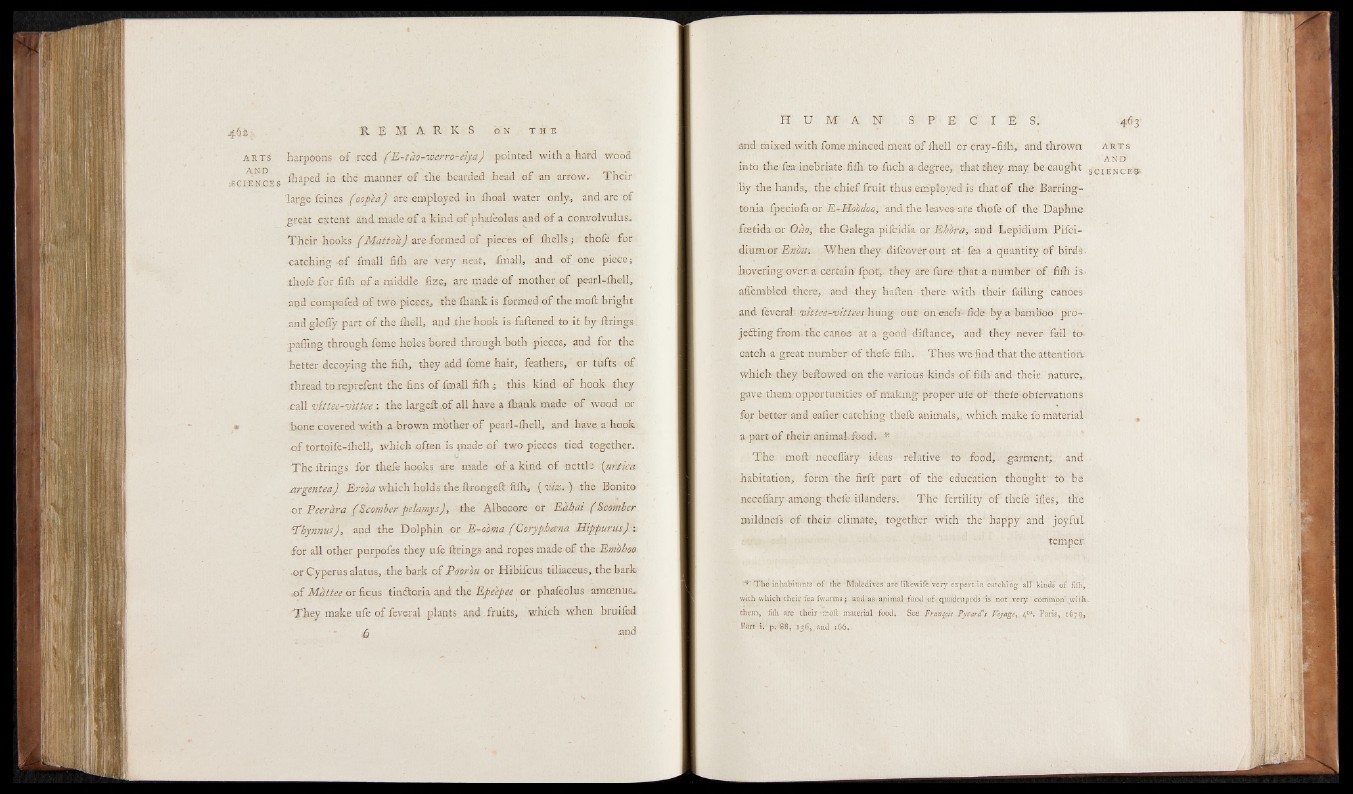
462 ■ R E i A R K S O N T H F.
a r t s ' harpoons o f reed (E-tab-iberro-eiyei) pointed with a hard wood
^ ihaped in the manner o f -the bearded .head of an arrow-- Their
large feines (oopea) are employed in fhoal water only,, and are of
great extent and made o f a kind o f phafeolas and of a convolvulus-
Their hooks (Mattou) are formed o f pieces of ihells; thofe for
-catching -of fmall filh are very neat, fina-11, and. o f one piece;
thofe for fifh o f a middle fize, are made o f mother o f pearl-lhell,
and compofed of two pieces, the fhank is formed o f the moft bright
and gloily part o f the Ihell, and the hook is faftened to it by firings
palling through feme holes bored through both pieces, and for the
better decoying the fifh, they add fome hair, feathers, or tufts o f
Thread to reprefent the fins of final! filh,; this kind of hook they
ca ll vittee-miUethe largeft.of all have a thank made o f wood or
hone covered w ith a brown mother o f pearl-lhell, and have a hook
o f tortoife-fliell, which often is made o f two pieces tied together-
T h e firings for thefe hooks are made o f a kind of nettle (urjica
argentea) Eroba which holds the ftrongeft fith, ( i»zt ) the Bonita
■ or Peerara ( Scomber pehynysJ, the Albecore or E/ibdi (Scomber.
Phynnus), and the Dolphin or E-omna ( Corypheena HippumsJ-.
for all other purpofes they ufe firings and ropes made o f the Emohoo
•or Cyperus alatus, the bark o f Pdorou or Hibifcus tiliaceus, the back-
o f Mattee or ficus tinftoria and the Epeepee or, phafeolus amcenus-
'They make ufe of feveral plants and . fruits, which when bruifed
b and
IT U M A N S P E C I E Sa
n d m i x e d .w i t h f o m e m i n c e d m e a t o f I h e l l o r c r a y - f i l h , a n d t h r o w n a r t s
. . . . AND
into the fea inebriate fifh to fuch a- degree, that they, may be caught s c ie n c e s ;
By the hands,. the chief fruit thus employed is that o f the Barring-
tonia fpeciofa or E-Hoodoo, and the leaves-'are thofe of the Daphne
feetida or Oho, the Galega pifeidia or Ebora,. and Lepidium Pifci-
dium or Enbut When they difeover out- at fea a quantity of birds •
hovering'.over a-certain fpotj, they are fu-re that, a number o f fifh is-
affembled there,, and they haften there with their failing canoes-
and feveral •oittee-vittee-s hung out on each- fide by a bamboo projecting
from the canoe at a good diftance, and they never fail t o
Gatch a great number o f thefe filh. Thus we find that the attention
which they bellowed; on the various kinds of- filh and their, nature,
gave them opportunities o f making proper ufe o f thefe obfervations ■
for better and eafier catching theft animals,., which, make fo material-
a part o f their, animabfood. ®
T h e moft neceflary ideas- relative to food,. garment;, and
habitation,, form the firft part of the education thought to be
neceflary among theft iflanders. T h e fertility of thefe ifles, the
mildnefs o f their climate, together, with the happy and joyful
temper
The inhabitants of' the MalëdiVcs are liKéwifé very expert in catching all’ kinds of fifh,
with which their fea fwarras j and as animal food of quadrupeds is hot yety common' with
them, -filh are their moft material food. See. François Pyrcwd’s Voyage^,4t0. Paris, 1679,
Part- i.',p."8€,. ij6 , and 166,